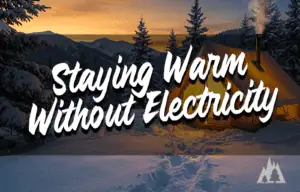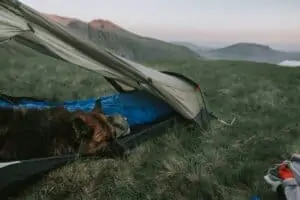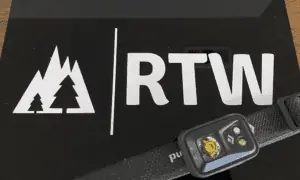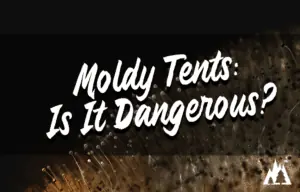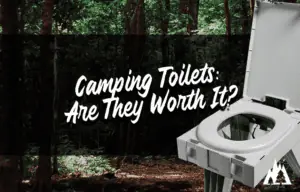Using a Pop-Up Camper in the Winter
RV popularity is exploding- according to KOA, more than half of campers plan or wish to RV in the coming year. Even while other styles of travel have dissipated during the pandemic, camping has soared in popularity, especially glamping and RVing. Pop-up campers are an amazing option for the traveler looking for a bridge between a tent and a full-sized camper.
Pop-up campers are ideal for summer travel, but they can be excellent for winter travel too.
Using a pop-up camper in the winter is a great adventure, but only when prepared correctly.
Keep reading all you need to know about using a pop-up camper for your winter trip.
How Pop-Up Campers Work
A pop-up camper is one of the most convenient methods of traveling, especially in the winter. As the name suggests, pop-up campers collapse for easier transport.
Here’s a pop-up camper when closed:
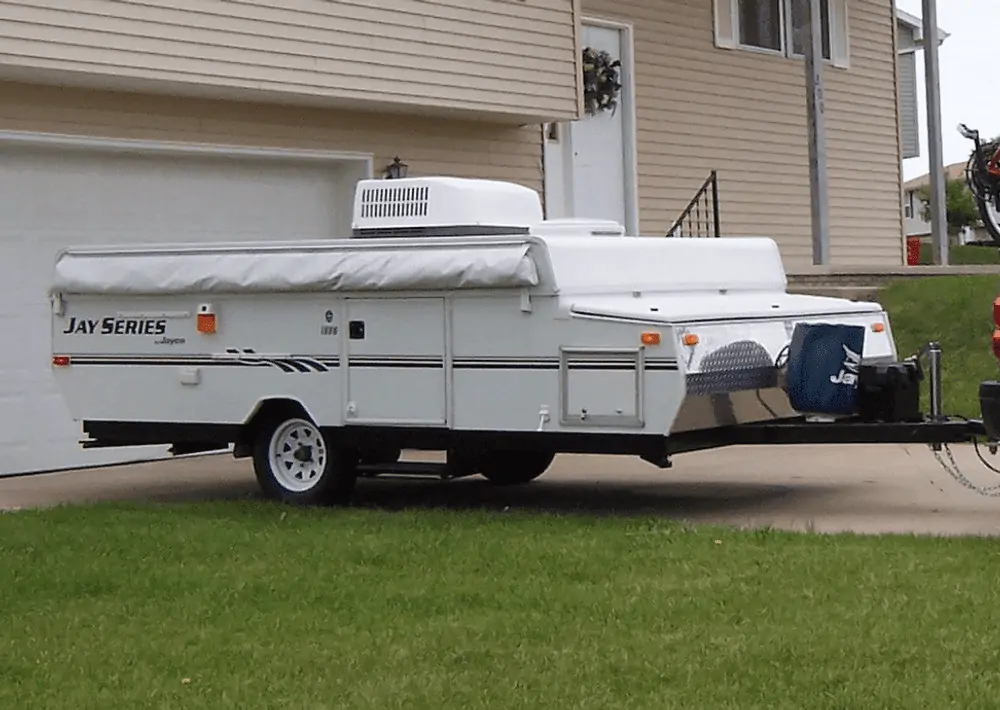
Here’s the same camper opened:
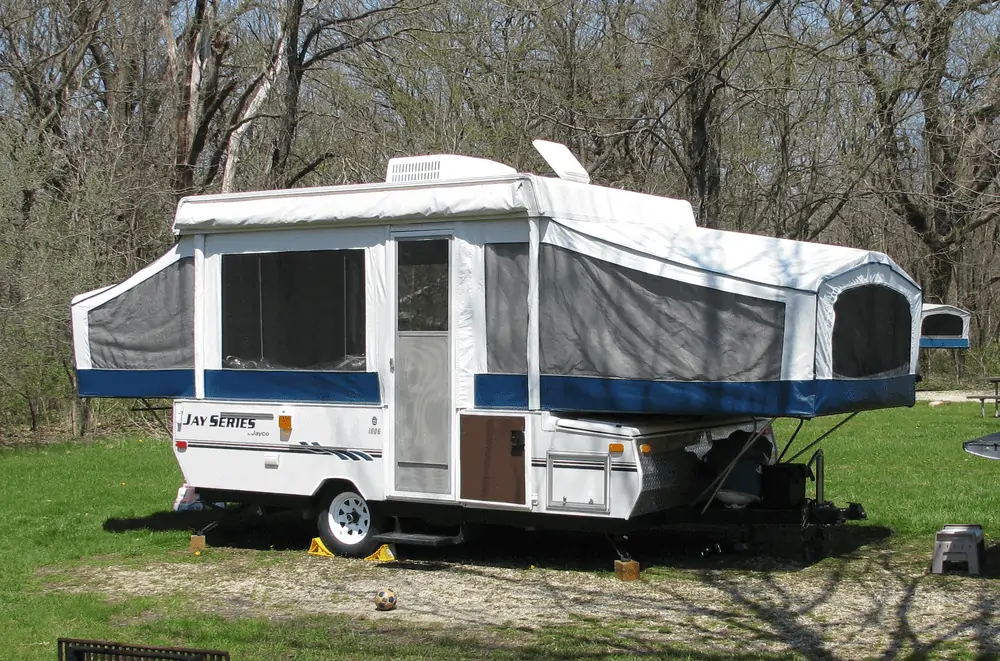
Full-size campers provide a lot of room, but that space isn’t needed while on the road. The empty space of a camper creates unnecessary bulk, slowing you down and making driving more difficult. Particularly in a harsh winter wind, the last thing you want is a large camper bogging you down.
A pop-up camper solves this problem. When you are ready to pack up and move on, a pop-up camper collapses down to a neatly flat surface that is much easier to navigate.
The setup and takedown are easy too- all you need to do is park on level ground, prop the camper on stabilizer jacks, and open the camper up. The campers open and close like an accordion, with folds in places that will not disturb the features inside.
Using a Pop-Up Camper in the Winter
A pop-up camper is a great option for traveling in the winter. There are some of us who are still dedicated to tent camping in the winter, but a camper provides the warmth and coziness a tent can’t beat.
A full-size camper can provide warmth, but it also makes it much more difficult to navigate in the winter. A full-size camper adds a lot of weight and bulk to your journey, which can limit where you can travel. In addition, gusty winter winds may make a full-sized camper unsafe for winter driving.
A pop-up camper is a happy medium between a traditional tent and a full-size camper. It includes the convenience and comfort of a camper without the bulk, and it has the ease of use of a tent without the chill.
Whether you are new to RVing or an old pro, there are some essential things to keep in mind when planning a winter trip. A pop-up camper is a great option for winter travel, but there are a few considerations to keep in mind when planning your trip: heating, water, and safety.
How to Keep Your Camper Warm in the Winter
There are a few methods for keeping a pop-up camper warm in the winter. It is important to ensure that your pop-up camper is well-insulated. There are a few options for creating heat in campers, but without proper insulation, that heat will vanish as fast as it is created.
Having a reliable heat source is essential for winter comfort. There are a few different types of heaters, and picking the best style for your trip may make all the difference in your comfort.
Heaters for Campers
There are 2 main types of heaters- electric and propane.
Many campers come with a built-in furnace that can circulate the hot air throughout the space. These propane-powered furnaces are also used to heat the water in your camper, allowing you to use just one propane source. Though the built-in heater may work decently, you may find you need to supplement it with an extra heat source in the winter months.
Pros:
- Convenience- the built-in camper heater prevents the need for buying an additional heater
- Hassle-free- the heater is built right into the wall of the camper for easy storage and transport, no extra effort needed
- Able to heat your water supply simultaneously
Cons:
- Efficiency may be questionable, depending on the model
- Built-in heaters can not be moved for heating specific areas
- Built-in heaters can not come with you outdoors
This is where a portable propane heater can come in. These portable heaters are powerful gadgets that can be used to add extra heat throughout the camper or heat one space specifically. Additionally, a portable heater can come with you on outdoor expeditions in the winter, such as ice fishing.
The portable propane heater is great for heating a bedroom space. The built-in safety features reduce the risk of carbon monoxide poisoning, and these heaters are great at providing extra heat for small areas.
Pros:
- Portability- bring the heater with you outdoors
- Great at heating specific areas of the camper and saving energy on the rest
- Easy to use
Cons:
- You may need multiple heaters to efficiently heat the entire camper in the winter
- You have to ensure you have plenty of propane available before leaving or risk being cold
As with any propane heater, it is also important to ensure you have carbon monoxide monitors inside of your camper. While these heaters come with some built-in safety features, it is always best to have an extra monitor in place.
A portable electric heater is a great alternative for those who do not want to deal with propane. This plug right into any outlet and are great at heating small areas. Additionally, many electric heaters come with some comfort features, like timers and remote controls.
However, it is important to note that an electric heater is only practical if there is a guarantee of a reliable power source; otherwise, you may end up very cold.
Pros:
- No need for propane, which can reduce your costs
- Many models come with features that make them even easier to use
- Great for heating just one space
Cons:
- Can be used to heat specific spaces in the camper but cannot go beyond the reach of an outlet
- A reliable power source is essential- you won’t be able to venture too deep into the backcountry with just an electric heater in the winter
When planning for a cold winter journey in your pop-up camper, it may be best to have a few different sources of heat to rely on in the event of an emergency. The last thing you want is to have to leave early due to the cold!
Pop-Up Camper Insulation
Now that you have reliable sources of heat for your pop-up camper, you will want to insulate it to prevent that hot air from escaping. Unfortunately, the pop-up design of these campers creates several different points at which warm air will escape.
Seams and Edges
The first thing you will want to do while prepping for your trip is evaluate your camper for any potential leaks. Assess the seams of the camper for anywhere that could be a potential leak point. These leaks may be small, but they add up to a very uncomfortable night.
Tape and silicone leak sealers are great for supporting your seams. Running these along the edges of your pop-up camper can make all the difference.
Under the Bed
It is especially important to insulate under your bed. In many models of pop-up campers, the beds are the spaces that “pop out” and are elevated over the air. This means your bed may be completely surrounded by the outside air, making for some very chilly winter nights.
Insulating underneath your bed can make a big impact. Seal any leaks with tape or silicone sealant, and consider supplementing the bedroom area with insulation boards beneath the mattress. Foam insulation boards can be found cheaply from anywhere and make a great added layer of protection.
Under the Camper
If your camper did not come with a skirt, you might want to invest in an RV skirt. These skirts fit along the bottom of the camper and help prevent cold air from circulating underneath the camper, making your floors cooler.
RV skirting helps keep your entire camper insulated and warm on chilly nights.
The Doors and Windows
Doors naturally will let some of the warmed air in and out. Unfortunately, they can also be a major source of leaks.
Weather strips can help reduce any leaks caused by your doors. Additionally, thermal curtains are available to rest in front of your doors and add an extra layer of protection.
If your camper has lots of windows, it is a good idea to make insulation panes for your windows at night. During the day, the windows let in sunlight, but at night they allow heat to escape. A removable pane that can be placed in front of the windows at night will help keep that warm air inside.
The Roof
Another area where a leak could occur is the roof. Small holes can quickly turn into rapid escape valves. Remember, heat rises, so insulating your roof is essential.
Before any winter trip, be sure to assess the roof of your pop-up camper for any potential damage. If you want to ensure the best insulation for your roof, an insulating tarp can help provide an extra layer of protection for your camper.
Keeping a Fresh Water Supply
A concern when traveling in a pop-up camper in the winter is maintaining a water supply that isn’t frozen. Being out in a remote area with frozen water lines can lead to catastrophe. Even if your camper is hooked up with water lines, it is a good idea to bring some water bottles along as well to be safe.
Skirting your camper is essential for reducing cold air flow underneath your camper. However, if you are planning to take your RV into frigid temperatures, skirting alone will not suffice.
Insulated hosing is the best way to go. By using heat tape and foam insulation, you can significantly reduce heat loss. Insulating your water heater can have a similar effect- up to 45% of standby heat losses can be prevented by insulating your water heater.
If you are regularly camping in ice-cold temperatures, consider investing in a heated hose. They can make it much easier to prevent your water from freezing.
Winter Vacation Campers: What to Pack
Even with all the heating and insulation possible, it is still vital to pack appropriately for cold weather. Thermal clothing is essential for being comfortable while camping in the winter. Good thermal wear is thin and comfortable to move in but very warm.
When the sun sets and the night settles in, temperatures will take a sharp drop. It is important to be prepared with thermal pajamas that will keep you cozy all night long.
High-quality socks and shoes are just as essential for outdoor time. Investing in wool socks prevents pain in the long run, wicking away moisture, keeping you warm, and preventing blisters. Depending on your plans, you will want to invest in a high-quality hiking boot or shoe that will keep your feet warm even after hours outside.
In addition to great gear, be sure to bring along warm blankets and sleeping bags. The sleeping bag industry has come a long way- some sleeping bags can keep you warm in even the extreme negatives! Be sure to bring quality materials so you can stay comfortable on your trip.
Time to Prepare for Your Next Winter Camping Trip
Using a pop-up camper in the winter is a great way to travel and explore while keeping warm. The ease of use and the portability makes pop-up campers practical for any journey. However, there are a few important steps to take before embarking on a winter camping trip.
Heating and insulating your camper is essential for having an enjoyable trip. Assess and seal any leaking points, add extra layers of insulation where necessary, and invest in a high-quality heater or two. Now that you are prepared for cold travels, you are ready to enjoy a fantastic winter vacation in your pop-up camper!
For more great camping tips, check out our camping guide.

